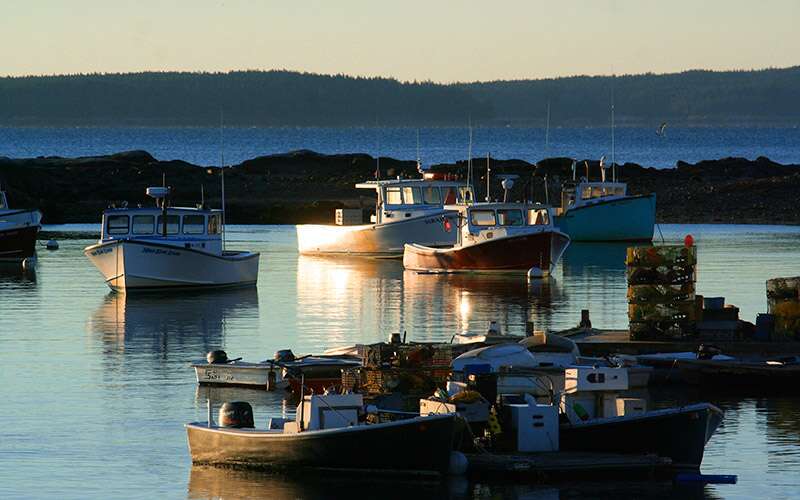
Lobster landings post turnaround, Maine's fisheries' overall value second highest on record
 Courtesy / Office of U.S. Sen. Angus King
U.S. Sen. Angus King, I-Maine, speaks with Patrice McCarron, executive director of the Maine Lobstermen's Association, at the Maine Fishermen's Forum that took place in Rockport this past weekend.
Courtesy / Office of U.S. Sen. Angus King
U.S. Sen. Angus King, I-Maine, speaks with Patrice McCarron, executive director of the Maine Lobstermen's Association, at the Maine Fishermen's Forum that took place in Rockport this past weekend.
Maine's lobster harvesters had a strong year in 2018, landing 119.64 million pounds.
That was an increase of nearly 8 million pounds over 2017’s figure of 111.9 million pounds, according to a Department of Marine Resources news release.
The landings peak was in 2016, when 132.6 million pounds were harvested, after four years in the range of 122 million to 127 million pounds, according to the agency’s data.
Last year was the seventh time in history that landings exceeding 110 million pounds.
At $484.544 million, the value of Maine's lobster fishery climbed by more than $46 million over 2017 on the strength of a boat price that increased from $3.92 per-pound in 2017 to $4.05 in 2018.
U.S. Sen. Angus King, I-Maine, during a visit to Maine Fishermen’s Forum in Rockport over the weekend, took the occasion to commend the work of the men and women in Maine’s fishing industry, "whose hard work drives the economy and helps support families and communities up and down the coast.”
But he also highlighted in a news release the threat to Maine’s lobster fishery posed by climate change and the increasingly warmer temperatures in the Gulf of Maine that are causing lobsters to migrate northward to cooler waters.
Lobster is U.S.'s most valuable species

According to data published by the National Oceanic and Atmospheric Administration, American lobster was the most valuable single species harvested in the U.S. in 2015, 2016 and 2017, with Maine landings accounting for approximately 80% of that value each year.
"Maine's commercial fishing industries remain a critically important driver for our state's economy and identity," Department of Marine Resources Commissioner Patrick Keliher said in the release. "However, there are challenges we must tackle to sustain our marine resources and the communities they support. We must continue to look at adapting to a changing Gulf of Maine while facing related challenges that include a pending bait shortage and whale rules.”
Lobster marketing will be 'hyper targeted'
Building on several years of strong catches, the Maine Lobster Marketing Collaborative is including additional points on the supply chain in its strategy this year, according to a March 1 news release.
Now in its fifth year, the collaborative plans to build on efforts aimed at chefs, media and consumers with a more targeted focus on distributors within the supply chain through education about lobster use, handling and prep.
Overall, marketing efforts focus on key areas including seasonality, origin and culinary versatility, as well as the industry’s tradition of sustainability that dates back well over 150 years, according to the release. The 2019 plan is expected to include the creation of relevant and hyper-targeted educational content, earned media campaigns that drive awareness and demand throughout the supply chain, the celebration of the fifth annual National Lobster Day and continued digital content, proactive and reactive earned efforts and issues management.
Matt Jacobson, who led the collaborative since its inception in 2013, stepped down as executive director on Feb. 25. A formal search process was launched for Jacobson's replacement, led by the collaborative's board of directors.
The collaborative’s marketing director, Marianne LaCroix, is interim executive director.
Overall fisheries value: Second highest on record
Overall, the value of Maine's 2018 commercially harvested marine resources increased by more than $60 million over 2017, and for only the third time in history exceeded $600 million.
At $637.175 million, the overall value represents the second highest on record, according to preliminary data from the Department of Marine Resources.
"This industry is the cornerstone of Maine's coastal economy, and the value of this year's catch reflects the dedication and sacrifices of the men and women who work on the water and those who make sure this quality product gets to market,” Gov. Janet Mills said in the news release
Despite a season shortened by illegal sales, which put the state in jeopardy of exceeding its allotted quota, elver harvesters pocketed $21.747 million in 2018. The total was an increase of $9.5 million, or 78%, over 2017, and ranked the fishery as Maine's second most valuable.
A record per-pound price for Maine elvers of $2,366 resulted in an overall value that makes 2018 the third most lucrative in the fishery's history, behind only 2012 and 2013 — years in which there was no quota for elvers.
The value of Atlantic herring placed it third overall at $16.566 million, notwithstanding harvest levels that were 3.6 million pounds lower than 2017.
Softshell clam harvesters earned an additional $514,768 over 2017 because of an increase over 2017 of 258,642 pounds harvested. At $12.855 million, the fishery was Maine's fourth most valuable in 2018.
Sea urchins and scallops ranked fifth and sixth, respectively, in value of harvested resources. Harvesters landed 2,041,633 pounds of urchins valued at $6.202 million. Maine scallop harvesters landed 239,428 pounds less in 2018 than in 2017 which, combined with a decrease of $1.20 per pound, resulted in a decline in value from 2017 of $3.489 million for a total of $5.936 million.
Underscoring the importance of commercial fishing to Maine is the most recent data from the Atlantic Coastal Cooperative Statistics Program, which reveals that Maine commercial harvesters took more than twice the number of commercial fishing trips than any state on the East Coast. In 2017, Maine harvesters reported 447,523 trips, while harvesters from Virginia, the next highest state, reported just 217,940.













0 Comments